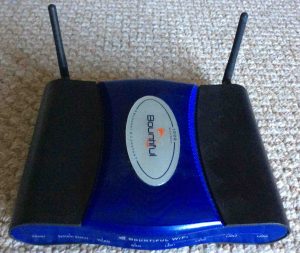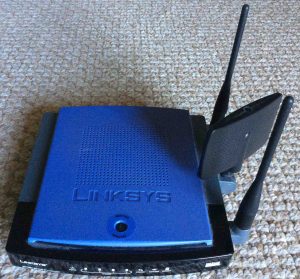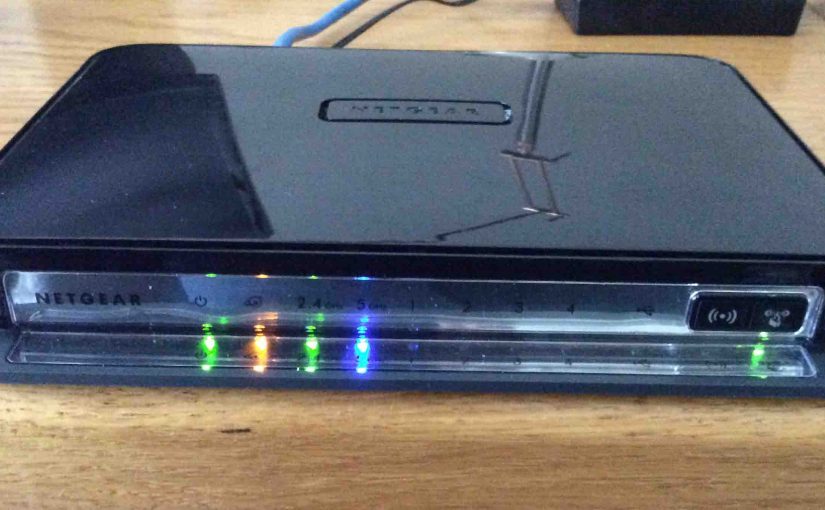Here’s how to tell when it’s time to replace WiFi wireless router or access point.
Overall performance and reliability should most drive this choice. Indeed, many factors can make replacing the router a good idea. These include…
- The router’s age.
- Overall physical condition.
- How old its WiFi and security tech is.
- and other factors.
The list below gives the key signs that tell when to replace your WiFi wireless router.
Time to Replace WiFi Wireless Router When…
The Bountiful WiFi high power WiFi router shown next, was big in 2007 through 2011. It does not support wireless AC speeds though. So if you have this one, yank it and replace it. You’ll get much faster WiFi if you do.

Replace WiFi Wireless Router When Original Router is More than Three to Five Years Old
We see rapid advance of WiFi tech these days. So, just like tablets and gaming consoles, wireless routers quickly grow out of date. Newer routers quickly outpace the elder’s speed, coverage, settings, and so on.
Replace WiFi Wireless Router When Status Lamps No Longer Light or are Too Dim to See
Nowadays, routers have those long-lasting LEDs as either single or multi-color status lamps. So if these have burned out or become dim, this is a sign of many hours of use. It likely means that the router will soon fail. Or, it suffers more errors and speed loss due to its aging parts.
Keep in mind that LEDs are solid state devices. So are the circuits inside. So, if the LEDs are dimming, then these other parts may also be enjoying their final days.
But check your router’s power supply before you replace the router. Make sure it outputs the right voltage. Lower-than-spec voltage from the power cord can also cause dim lights and reduced router function. But if the supply has the voltage it’s supposed to, then the router is likely dying. So replace it when you can.
Replace WiFi Wireless Router When you Notice a Discolored Plastic Case
A WiFi router may show warp or color fading on its case and panels. This means either that the router has overheated sometime during its life. Or it could simply mean that it’s been running for quite some time. In either case, too much heat over too long a time degrades router parts. So if there are these signs, you’re likely not getting the best from your router anymore. So, replace it.
Replace WiFi Wireless Router When your Current Router Does Not Offer Dual-Band Operation
Most older routers operate exclusively in the 2.4 Ghz. radio band. Unfortunately, that range of frequencies is also occupied by cordless phones, Bluetooth devices, microwave ovens, and baby monitors. 2.4 Ghz. has much traffic on it these days; particularly in the close quarters of urban living.
Replace WiFi Wireless Router When Your Existing Router Does Not Support Gigabit Ethernet
Routers prior to roughly 2012, provided only 10/100 Mbps Ethernet ports on their LAN side. And some of them had just a 10 Mbps port on the WAN side. Today’s top home internet speeds are nearing 300 megabits per second and beyond. So you want to make sure your router is not decreasing these speeds. So you should replace slower routers for the fastest internet speeds on all your attached devices. Replace your wireless router if any of its Ethernet ports are less than 1 Gbps.
Replace WiFi Wireless Router When Firmware Updates Stop Coming
Try upgrading your current router to the latest firmware. That firmware version date should be less than three years ago. If it’s older than that, then the manufacturer likely no longer provides updates for that router. Plus, they either have or will likely stop supporting it altogether.
Weaker WiFi Signal
Over several years of constant up-time, a wireless router’s signal strength often declines. Power supply output can fall. RF amplifier circuits often degrade due to constant heating. This all comes from increasing number of hours of use.
Further, even if your old router hasn’t lost power, the newer models use better antenna design. In fact, many units feature adjustable output power. That highest power setting is a good deal higher than, say, 2007 vintage routers
Frequent Loss of Internet Connection
With increasing frequency, you may lose the internet connection. Yes, you might still be able to log on to your router through WiFi. But surfing the web may not work at all, or go quite slowly.
Replace WiFi Wireless Router When Faster WiFi Standards Appear
Every few years, a new 802.11 wireless protocol comes out. These new standards are often much faster than prior ones. For instance, the max data rate for 802.11b, in the late 1990s is 11 megabits per second.
802.11g, popular in the first decade of the 21st century, supports speeds of up to 54 mega bits per second. 802.11n, popular from roughly 2008 to 2013, supplies data speeds of up to 300 Mbps.
Then finally, there’s the new 802.11ac, with data rates up into the gigabits per second range. This rapidly gaining speed trend is likely to continue for the foreseeable future. So if you want state-of-the-art data rates, then replace your router every few years.
Replace WiFi Wireless Router When New Security Features Come Out
Today’s computer hackers can get into “secure” wireless networks so easily. Plus, the damage they can do once in, is costly. So keep your router up to date in terms of the security protocols it uses. If someone hacked your secured home network, then it’s time for a new router. Replace a router that supports less than the WPA2 security right away.
Replace WiFi Wireless Router when your Old Router No Longer Cuts the Mustard
Maybe you’ve noticed excessive stuttering in your favorite live video or audio streams. Or, connections to Internet radio stations fail more frequently than you believe they should. Or, your other electronic appliances easily interfere with your wireless connections. Advances happen all the time to reduce these wireless drawbacks. So if you see this more than a few times a month, then replace your WiFi router.
We bought the Linksys WRT300N WiFi router (pictured next) in the spring of 2007. It lasted until the summer of 2015, when it suddenly stopped accepting WiFi connection requests. We should have replaced it sooner than we did. But it was in an environment that required nothing faster than Draft 802.11n.

If at least three of the above signs describe your current router, then we suggest that you replace it. Get a new one that shows none of the list items above. Buy a state-of-the-art wireless router.
Related Posts to When to Replace WiFi Wireless Router
- Netgear WNDR3700v4 N600 Dual Band Router Review
- Asus RT AC87R Router AC2400 Review
- Linksys WRT300N Router Review, Wireless-N Broadband
- Bountiful WiFi BWRG1000 Wireless Router Review
- Belkin AC1200 DB Review, WiFi Dual Band F9K1113 Router
- How to Choose a Wireless Router
- Asus RT-AC87R Router Boosts Wifi Reliability, Big Time!
- Netgear N750 WiFi Gigabit Router WNDR4300 Review
- How to Fix Common WiFi Router Problems and Issues
- How to Replace Old or Defective Wireless Wi-Fi Router
References for When to Replace WiFi Wireless Router
Revision History
- 2019-06-10: Tuned the targeting for ‘When to Replace WiFi Wireless Router’, removed ad code, and added more tags and links.
- 2018-12-29: Updated post title and added subheadings.
- 2015-01-13: Added more appropriate tags.
- 2015-10-01: Added appropriate tags.
- 2015-07-19: Originally published.
